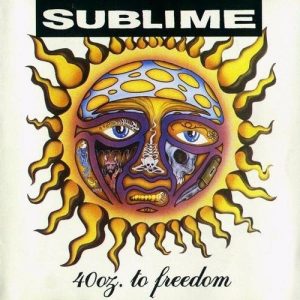
What Went Into 40oz. to Freedom
Many great artists are also great fans of art. Sublime’s debut album, 40oz. to Freedom, shows how art can inspire and influence the art of its fans. The fan’s art can be a continuation of the style and form of the original artists, or it can be a new take on it, as is the case with 40oz. to Freedom. Regardless, elements of the original artwork are so deeply ingrained in the “second generation” of artwork–which, of course, is a misnomer, since the “original” artwork was also inspired and influenced by other works–that removing the “original” artwork from existence would drastically change, and perhaps erase, the “second generation” of it. The interlinked position of being a fan and a creator of culture shows that a function of culture is to provide an opportunity for new artistic creations.
“Punk rock changed our lives,” is the opening line of 40oz. to Freedom. Right off the bat, it gives you an idea about how deeply the band’s influences affected its music. The message is true: punk plays perhaps the greatest role of any genre on Sublime’s 23-track walk through punk, hip-hop and a variety of subsets of Jamaican music, among others. If a person was tasked with assigning a single genre to Sublime, cross-listings like ska-punk disallowed, punk would be the best choice. On top of that, a tuned-in Sublime fan will notice that the voice speak-singing the album’s first line is not lead singer Bradley Nowell’s. It is a sample of the punk band Minutemen’s “History Lesson Part 2,” off of their 1984 classic, Double Nickels on the Dime. So not only is Sublime telling us how important the punk they listen to is to them, and thus their music, but an actual piece of this punk makes its way into their own, original music. This is not a one-time occurrence. The songs on the album have an average of three to five samples each (source: Whosampled). Every time a sample is used, a member of Sublime is taking something he enjoyed, or multiple members enjoyed, and literally making it a part of their own creation.

The closing track on 40oz. to Freedom, “Thanx,” is less a track and more a list of everyone the band wants to express their gratitude towards. The list includes club owners, drug dealers, their families, friends and a dog. But most of all, it includes bands and artists who they appreciate, or in their words, who gave them “‘nuff inspiration, ‘nuff respect.” A few of the over 50 artists mentioned are Bad Religion, Bob Marley, Butthole Surfers, Imagining Yellow Suns and KRS-One (source: Genius). None of the artists Nowell pays tribute to made the same kind of music he did. Bad Religion makes fairly typical punk music: short, loud, fast-paced and anti-establishment. Marley, of course, is the defining sound of reggae. Butthole Surfers is more experimental and psychedelic, while their punk roots are always evident. Imagining Yellow Suns has such a drugged-out sound that it’s easy to see why their work didn’t catch on outside of the Long Beach community from which Sublime hails. KRS-One is a Bronx rapper known for his genre-blending techniques as well as politically-minded lyrics. After having heard the first 22 tracks of 40 Oz. To Freedom, a listener might feel some misgivings about saying Sublime’s music stems from the work of the artists mentioned, because its music is so distinct from any of them. To say Sublime is punk, reggae, hip-hop, experimental or psychedelic rock so woefully neglects the other musical styles present in their music that it would seem to be entirely inaccurate. But listen to “New Thrash,” a minute and a half of yelling about rejecting what people always tell them, backed by a fast-paced, crushingly loud pair of guitars and drums, and say it wouldn’t fit perfectly on a Bad Religion album. Listen to how the guitar is played in the first ten seconds of the title track, and it’ll remind you of Bob Marley, the embodiment of reggae music. And right after hearing “54-46 That’s My Number/Ball and Chain,” half a cover of a rocksteady classic and half a punk protest of the marriage institution, listen to “Badfish,” and be taken on a peaceful, metaphorical exploration that only someone deep into drugs can produce. In sound and in purpose, “Badfish” is more like the Butthole Surfer’s cover of “Hurdy Gurdy Man,” or a trippy Imagine Yellow Suns track than anything punk. And then Nowell raps on “Live at E’s,” and while you hear a white guy trying with limited success to spit a few bars, you can see he’s taking a few of his cues, such as dub beats, from KRS-One, who he later dedicates an entire song to. So, Sublime is not any one of the artists on “Thanx,” it is every one of them, at different times and in different places, and sometimes, at the same time and in the same place. The best way to gain an understanding about Sublime’s music without actually listening to it is not through description, but through familiarizing yourself with its member’s favorite artists. The term ska-punk, the critics’ favorite for classifying Sublime, is rather meaningless until you’ve actually heard it played, and it leaves out many elements of Sublime’s style, including hip-hop. The singers and bands that are given credit on “Thanx” contain, in sum, nearly every influence that goes into 40 Oz. To Freedom, and as such, give an accurate representation of the type of music the album consists of.
Sublime’s very specific, though diverse, taste in music shows that its members are not the passive consumers of culture that Theodor Adorno labels the masses, but are in fact actively modifying their tastes as a reflection of their interests. To put it in the terms of Dr. Jim Taylor, professor at the University of San Francisco, Sublime is a consumer of “authentic culture,” rather than “synth culture” (Taylor, para. 4). Synth culture is created by corporations and “driven by the profit motive,” akin to the products of the culture industry (Taylor, para. 4). Authentic culture, on the other hand, is made “of the people, by the people and for the people” (Taylor, para. 10). It’s culture that people find and consume because they genuinely enjoy it. Of the artists mentioned on “Thanx,” there are a very high proportion of underground, Southern California punk rock groups. These groups, including Kenneth Ramsey, Rhino ‘59, Big Drill Car and the Ziggens, have something in common besides their music and homes: you’ve never heard of them. The fact that these groups are so clearly not part of popular culture shows that the culture industry that Adorno and Taylor describe has no power to dictate their consumption. Sublime went out and searched for these punk groups through entirely natural means: word of mouth, attending concerts and actually meeting and performing with them. This can be verified because without advertisement, there were no alternatives for how they would have come across these bands.
Sublime was so into California punk that they became part of it. In his article “Forty Years On, What Does Punk Rock Mean?” Christopher D. Shea of the New York Times defines punk music as “loud, fast and rebellious” (Shea, para. 1). For much of 40oz. to Freedom, Sublime was just that. From Nowell’s declaration that he will not be returning from the liquor store on the title track, behind a heavy guitar and drums combo, to the message that “We’re only gonna die for our own arrogance, that’s why we might as well take our time,” on their cover of Bad Religion’s anti-imperialistic “We’re Only Gonna Die,” to Nowell’s idea that “Marriage doesn’t work in the world today,” on “New Thrash,” all of which are sung quickly and at a very high volume, 40oz. to Freedom is very much, though not entirely, punk. But Sublime didn’t just make punk music, they were punks, and to be a punks, you have to do much more. A few of the experts quoted in Shea’s article stress the importance of a D.I.Y. attitude in punk, which 40oz. to Freedom embraces with entirely in-house production and a record label started by Nowell (Shea, para. 4, 6). Danny Fields, former manager of the Ramones, adds youth and originality to the mix (Shea, para. 7). Sublime had plenty of both, with its unique blend of musical styles and with all its members being under 25 at the time of 40oz.’s release. They also rocked a punk style with a California twist, sporting buzz cuts, tattoos, sunglasses and often, no shirts.

It could be said that none of the points raised thus far are surprising or significant: no one would deny Sublime’s eclectic influences, or the fact that they are California punks. But in proving the extent to which these facts are true, and how they are true, it’s revealed that the members of Sublime mirror the slash fandom that Constance Penley describes in “Feminism, Psychoanalysis, and the Study of Popular Culture.” The artists Sublime listened to forged the opportunity for the creation of Sublime’s music, just as reading slash publications inspired and allowed fans to create their own zine artwork. Like many slash fanatics, the members of Sublime are clearly both fans and creative in their own right. But what really strengthens the tie between 40oz. to Freedom and Penley’s arguments is that the members of Sublime are part of the California punk subculture, just as Penley and the group she describes are part of the slash fandom. Those in the slash fandom didn’t enjoy the occasional slash zine; they consumed hundreds of them, eagerly anticipating new releases of their favorite varieties. Likewise, members of Sublime didn’t listen to California punk when it happened to come on the radio (it never did); they jammed out to it everyday. They dressed punk, they followed punk, they made punk, they were punks. Also, like slash zines, the underground punk Sublime listened to went unadvertised. In fact, both were hidden–slash zines behind the counter in comic book stores and punk performances in little known punk clubs–due to their perceived crassness. As such, consumers of both were free from the manipulation of the culture industry. Both represent forms of authentic culture.
With the similarities between Sublime and slash fans in mind, 40oz. to Freedom provides further evidence for the attacks that Penley makes on the Adornian argument of the function of culture. Both 40oz. to Freedom and the creations of slash fans show that culture serves a purpose outside of “infecting everything with sameness.” Culture, especially authentic culture, can serve as a template for the artwork of its fans. In fact, the influences of 40oz. to Freedom are removed once more from “infecting everything with sameness,” as Sublime took the works of their favorite artists and made their own particular blend of music, while slash fans simply made more slash zines. Perhaps the best way to show how inseparable Sublime’s role as a fan of culture is to their role as a creator of culture is by imagining that all the artists that Sublime cherishes were wiped off the face of the earth; that is to say, none of them ever picked up a guitar or sung a note. If this occurred, 40oz. to Freedom would also cease to exist.
Works Cited
“40oz. to Freedom (1992).” Whosampled, “40oz. to Freedom (1992).” Whosampled, www.whosampled.com/album/Sublime/40Oz.-To-Freedom/. Accessed 15 Nov. 2017 .
“Thanx.” Genius, https://genius.com/Sublime-thanx-lyrics. Accessed 15 Nov. 2017.
Taylor, Jim. “Popular Culture: We Are What We Consume.” Psychology Today, 8 Dec. 2009, www.psychologytoday.com/blog/the-power-prime/200912/popular-culture-we-are-what-we-consume. Accessed 15 Nov. 2017.
Shea, Christopher D. “Forty Years On, What Does Punk Rock Mean?” New York Times, 14 Aug. 2016, www.nytimes.com/2016/08/15/arts/music/punk-rock-defined-buzzcocks-henry-rollins.html. Accessed 15 Nov. 2017.
Edited by Isaac